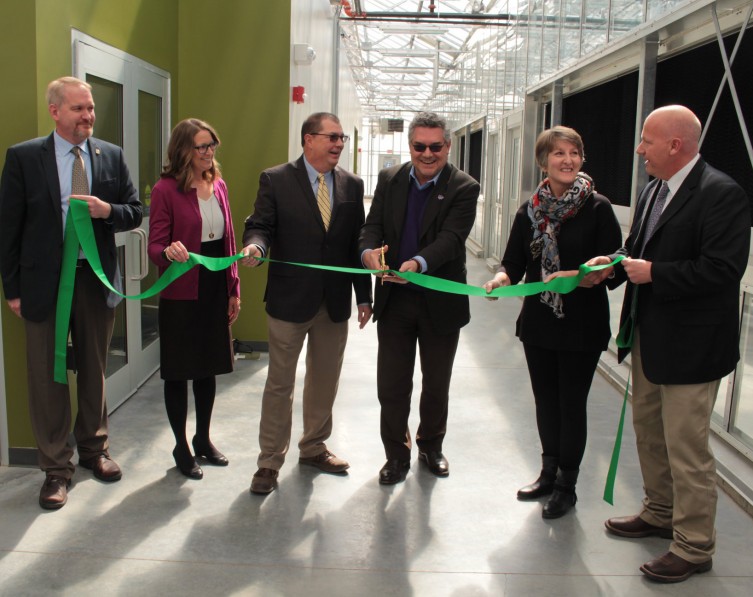Breadcrumb
- Home
- Recent news stories
- Kansas Wheat dedicates new greenhouse expansion
On March 14, 2018, the Kansas Wheat Innovation Center (KWIC) unveiled its new 12,750 square-foot greenhouse expansion. These four new bays will house critical wheat research for Kansas State University and Heartland Plant Innovations. This brings the KWIC Greenhouse complex to more than 22,750 square feet of greenhouse space dedicated to cutting edge wheat genetic improvements for Kansas wheat farmers.

Pictured: Aaron Harries, Kansas Wheat; Angela Belden Martinez, EDA; Mike McClellan, KWC Chairman; Dean John Floros, KSU College of Agriculture; Betsy Wearing, Dane Hansen Foundation; Justin Gilpin, Kansas Wheat
These new greenhouses will be the home to researchers from the Wheat Genetics Resource Center, Kansas State University’s Poland Lab for Wheat Genetics and Heartland Plant Innovations. Molecular and genetic research done in the KWIC laboratories will be supported by the greenhouses and a larger, more controlled environment will both enhance and accelerate results.
As part of the dedication ceremony, Kansas State University’s Bikram Gill, Distinguished Professor of Plant Pathology, spoke about the recent sequencing of the wheat genome, which is about five times larger than the human genome.“Finally, after more than a dozen years of hard work, we deciphered the wheat genetic code, and we held a celebration at our annual meetings in mid-January 2018 in San Diego,” said Gill. “This seminal effort of long-term investment in wheat genetics by KSU and Kansas Wheat Commission (KWC) really began in 1979.”
He continued, “In 1979, the Kansas Legislature funded my position in wheat biotechnology for feeding new genetics in support of the wheat breeding program. And in 1981, the KWC made a down payment of $10,000 to establish a Wheat Genetics Resource Center at KSU. This annual support grew over the years and was at $100,000 per year for a total investment of $2 million until 2013 when I began my phased retirement. We leveraged this investment with another investment of over $25 million from extramural funds over this time.”
The Kansas Wheat Innovation Center was initially completed in November 2012. It represents the state’s single-largest, farmer investment in wheat research. It was built by the Kansas Wheat Commission, through the Kansas wheat checkoff, to get improved wheat varieties into the hands of farmers faster. It is home to the Wheat Genetics Resource Center.
“In concluding, I want to thank my fellow farmers (I am a farmer boy) and KWC for their faith and investment,” said Gill. “One thing more — I am going to donate $10,000 to the KWC Research Foundation as a pay back of $10,000 of Kansas farmers’ grant money that founded WGRC!”
The internationally-recognized Wheat Genetics Resource Center has a mission to assure future advances in wheat breeding by harnessing genetic traits from wild wheat relatives collected from around the globe. While the WGRC already has lab space and a gene bank at KWIC, it recently moved into its own greenhouse bay in the expansion. Researchers for the WGRC are working to discover genes for drought tolerance and resistance to viral, bacterial, fungal and insect pests. Once these genes are identified, they are transferred to modern breeding lines, ultimately to be released for farmers around the world.
The Poland Lab for Wheat Genetics at Kansas State University focuses on developing improved wheat germplasm along with novel breeding tools and methodologies. Research areas include technologies such as developing uses for drones in wheat improvement, high-throughput phenotyping, prediction models for wheat breeding, genome sequencing and much more.
Heartland Plant Innovations works to develop advanced technologies for gene discovery, trait validation and crop improvement. It was created with the intent of revolutionizing plant breeding and genetics. HPI focuses on doubled haploid production (a process that cuts five to seven years off of wheat variety development), trait development, contract research and wide crossing (a joint program with the WGRC that inserts traits from ancient wheat into modern varieties).
The 12,750 square-foot expansion was constructed adjacent to the existing four greenhouse bays, offices and laboratories at the KWIC. The new space includes separate rooms for potting, seed processing, soil preparation and a soil room to receive and handle bulk potting. Special temperature control and grid lighting systems are also included in the project.
The majority of the funding for the expansion came from the U.S. Department of Commerce’s Economic Development Administration, Kansas State University and the Kansas Wheat Commission, with additional support from the Dane G. Hansen Foundation.
